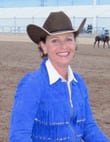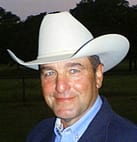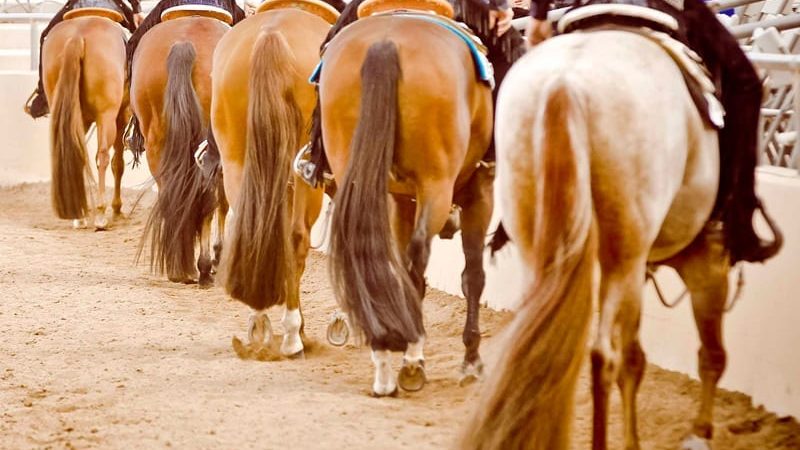AQHA Executive Director of Judges Alex Ross recently sent the judges an update specifically addressing the western pleasure class. In recent years, there have been some positive changes in western pleasure. However, in recent months, Ross has received calls and emails from multiple well-educated judges that expressed their feelings that the class is regressing. Specifically, these judges feel the horses are being shown at a slower pace with the over-canted horse becoming more apparent than in the past couple of years.
“Most of the issues we see in western pleasure are created by lack of flow. When a horse is over-canted, it generally lacks forward motion and/or self-carriage,” Ross states. “Because of this unnatural position, the horse ‘bobs’ its head when loping and leaves the outside hock behind the hip (also known as a split hock).”
Ross says that the judges need to follow the guidelines stated in Rule 465(B). “As the judge, through your gait calls and especially your placing, you have the opportunity to tell the exhibitors how they will be judged,” says Ross in the update. “Utilize both to your advantage and assist us in moving western pleasure in a positive direction. If this is not the direction you want to go, you need to request to be removed from the list of AQHA-Approved Judges.”
With this recent news, GoHorseShow asked several judges about the western pleasure, and whether they have seen a setback in this class. Due to education of the judges and the public, many feel the western pleasure horses are the best they have ever been, while others believe not much has changed. Let us know what you think by voting in our poll and also by leaving your opinion in the comment section of this article.
 Pierre Briere–I’m not sure that you see the over-canted look at the weekend shows, but you do see it more at the larger shows where there are 20-25 horses in the pen and everyone is trying to stay behind each other. Western pleasure is the entry level for a young horse into the show arena, and their future show career depends on how well they are exhibited at an early age. The horse should be able to branch out, and many trainers can tell you that trying to teach a horse another event when it has been trained to be over-canted with his face jammed to the wall and butt to the inside is an absolute nightmare. You can’t do anything with the horse when you try to go off the rail. The over-canted look may give the horse the illusion of moving correctly, but they have less self-carriage, less lift and will be going a lot slower than a horse that is doing the gait correctly. We all need to abide by AQHA western pleasure rules, they are in place to help assure our western pleasure horses have a long, successful show career after western pleasure.
Pierre Briere–I’m not sure that you see the over-canted look at the weekend shows, but you do see it more at the larger shows where there are 20-25 horses in the pen and everyone is trying to stay behind each other. Western pleasure is the entry level for a young horse into the show arena, and their future show career depends on how well they are exhibited at an early age. The horse should be able to branch out, and many trainers can tell you that trying to teach a horse another event when it has been trained to be over-canted with his face jammed to the wall and butt to the inside is an absolute nightmare. You can’t do anything with the horse when you try to go off the rail. The over-canted look may give the horse the illusion of moving correctly, but they have less self-carriage, less lift and will be going a lot slower than a horse that is doing the gait correctly. We all need to abide by AQHA western pleasure rules, they are in place to help assure our western pleasure horses have a long, successful show career after western pleasure.
 Suzy Jeane–I think AQHA has done everything they can to educate the public that mistreatment of horses in not acceptable in our industry. The quality of the pleasure horses has gotten to such a premier level that I think everyone expects to see it at every show. However, there are horses that are just not as talented as others. There are inferior reiners where the exhibitor knows they are only capable of being a 70 horse–that is the same with the pleasure. The public needs to be aware where they are and what kind of competition is at that show. It is the judge’s responsibility to help the reputation of these horses by stepping them up and moving them forward if they are going too slow. I also think the leveling program will help with this problem where horses of the same talents will be competing against each other.
Suzy Jeane–I think AQHA has done everything they can to educate the public that mistreatment of horses in not acceptable in our industry. The quality of the pleasure horses has gotten to such a premier level that I think everyone expects to see it at every show. However, there are horses that are just not as talented as others. There are inferior reiners where the exhibitor knows they are only capable of being a 70 horse–that is the same with the pleasure. The public needs to be aware where they are and what kind of competition is at that show. It is the judge’s responsibility to help the reputation of these horses by stepping them up and moving them forward if they are going too slow. I also think the leveling program will help with this problem where horses of the same talents will be competing against each other.
 Doug Huls–Personally, I don’t agree that the western pleasure classes have regressed. I don’t feel I have seen horses crawling around–not like it was five or six years ago. Frankly, I was kind of surprised to see it in the news again. I really don’t think it is an issue like it has been in the past.
Doug Huls–Personally, I don’t agree that the western pleasure classes have regressed. I don’t feel I have seen horses crawling around–not like it was five or six years ago. Frankly, I was kind of surprised to see it in the news again. I really don’t think it is an issue like it has been in the past.
 Stephanie Lynn–I have actually seen more horses being too slow more so than over-canted. There appears to be a trend of horses hardly jogging to the point they aren’t even close to doing the gait correctly. This class is supposed to be comprise of three gaits but I’m beginning to wonder if the jog is becoming completely unimportant in this class. Several judges have let horses win that are gorgeous lopers but aren’t jogging. I think this issue bears more discussion.
Stephanie Lynn–I have actually seen more horses being too slow more so than over-canted. There appears to be a trend of horses hardly jogging to the point they aren’t even close to doing the gait correctly. This class is supposed to be comprise of three gaits but I’m beginning to wonder if the jog is becoming completely unimportant in this class. Several judges have let horses win that are gorgeous lopers but aren’t jogging. I think this issue bears more discussion.
 Russ Smith–I think it is more of a regional issue. There are horses in certain parts of the country like up north and on the east coast that appear to be more over-canted and a lot slower. It is mainly due to the weather, and the trainers having to ride indoors in small pens. I try to extend the gaits in the class if I feel they are going too slow. I don’t place the ones that don’t follow the rules of the class. It is the responsibility of the riders to show their horses correctly, otherwise they won’t be placed on my card.
Russ Smith–I think it is more of a regional issue. There are horses in certain parts of the country like up north and on the east coast that appear to be more over-canted and a lot slower. It is mainly due to the weather, and the trainers having to ride indoors in small pens. I try to extend the gaits in the class if I feel they are going too slow. I don’t place the ones that don’t follow the rules of the class. It is the responsibility of the riders to show their horses correctly, otherwise they won’t be placed on my card.
 Rick Christy–I think the western pleasure is the best it has ever been. Overall, I don’t think the class has regressed. Everyone seems to pick on the western pleasure, but look at the hunter classes these days—these classes have regressed considerably, and I think these classes need more attention these days than the pleasure classes.
Rick Christy–I think the western pleasure is the best it has ever been. Overall, I don’t think the class has regressed. Everyone seems to pick on the western pleasure, but look at the hunter classes these days—these classes have regressed considerably, and I think these classes need more attention these days than the pleasure classes.
 Tom McBeath–I think the issue is more regional, but I see an issue more in the horses not maintaining a steady rhythm. Riders are trying to get them to stay slower than they are capable to prevent them for passing even though they would look better if they maintained their cadence and flow. I don’t see the over-canted look as a problem as much as exhibitors needing to move their horses up to help them look better and to fit within the rules of the class.
Tom McBeath–I think the issue is more regional, but I see an issue more in the horses not maintaining a steady rhythm. Riders are trying to get them to stay slower than they are capable to prevent them for passing even though they would look better if they maintained their cadence and flow. I don’t see the over-canted look as a problem as much as exhibitors needing to move their horses up to help them look better and to fit within the rules of the class.
 Brent Tincher–I think it is a regional problem but I don’t think horses that are over-canted historically do very well at the big shows. I think the pleasure horses are the best they have ever been, and we have so many talented trainers that if we tell them what we want and reward them for following the rules, then, they will follow suit.
Brent Tincher–I think it is a regional problem but I don’t think horses that are over-canted historically do very well at the big shows. I think the pleasure horses are the best they have ever been, and we have so many talented trainers that if we tell them what we want and reward them for following the rules, then, they will follow suit.
 Charlene Carter–I recently judged a show that had a few canted horses in the green–the ones that were severe, I did not place. However, I did tell the line-up that there were some nice horses that I didn’t use, because they were too canted. They showed a little better in the following classes. Also, I will walk over close to the rail and look at the angles to let them know that I am questioning their frames. I totally dislike it–it’s simply trying to make inferior horse look superior and it doesn’t work. Makes a very contorted appearance. I feel that you find it in different areas, but not as a general rule.
Charlene Carter–I recently judged a show that had a few canted horses in the green–the ones that were severe, I did not place. However, I did tell the line-up that there were some nice horses that I didn’t use, because they were too canted. They showed a little better in the following classes. Also, I will walk over close to the rail and look at the angles to let them know that I am questioning their frames. I totally dislike it–it’s simply trying to make inferior horse look superior and it doesn’t work. Makes a very contorted appearance. I feel that you find it in different areas, but not as a general rule.
 Gretchen Mathes–I don’t think the class has gotten worse, and I think overall it is a lot better than several years ago when most of it was horrendous. The horses are now fat and shiny and trained well. Personally, I think what we need to do is take all the money put in the two year-old classes and put all of it into the 3, 4, and 5 year-old classes. I think that would improve the class and help the younger horses in the long run.
Gretchen Mathes–I don’t think the class has gotten worse, and I think overall it is a lot better than several years ago when most of it was horrendous. The horses are now fat and shiny and trained well. Personally, I think what we need to do is take all the money put in the two year-old classes and put all of it into the 3, 4, and 5 year-old classes. I think that would improve the class and help the younger horses in the long run.
——–
Please let us know what you think about this topic, vote in our poll!








